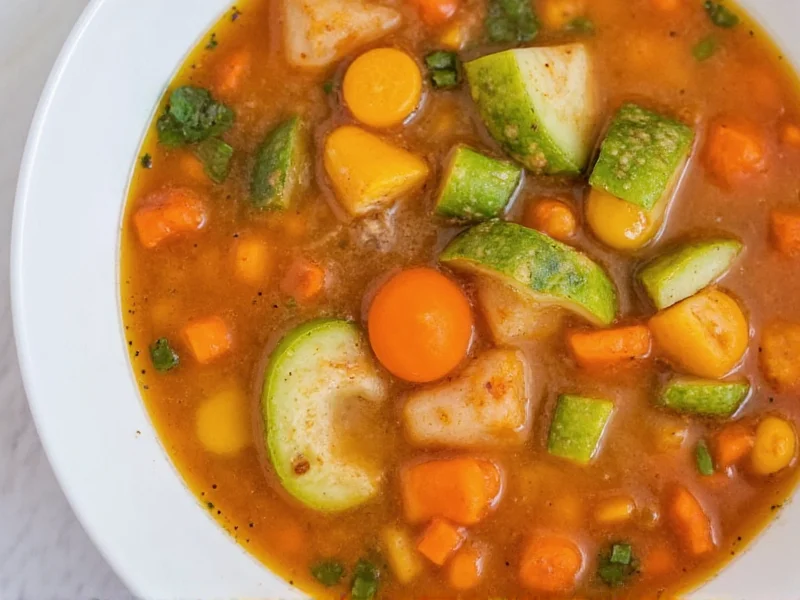Seasoning vegetable soup properly transforms a bland broth into a complex, satisfying meal. Many home cooks make the mistake of treating seasoning as an afterthought, but professional chefs know that flavor development happens in stages throughout the cooking process. Understanding vegetable soup seasoning techniques ensures your soup has depth, balance, and restaurant-quality taste without relying on store-bought broths or excessive sodium.
The Science Behind Vegetable Soup Seasoning
Vegetable soup presents unique seasoning challenges compared to meat-based soups. Without the natural umami from bones or meat, you must create depth through strategic ingredient layering. Vegetables themselves contain varying levels of natural sugars, bitterness, and earthiness that interact differently with seasonings at various cooking stages.
When learning how to season vegetable soup without meat broth, remember that water-soluble compounds in vegetables release gradually. Early-seasoning builds foundational flavors, while finishing touches brighten the final product. This progressive approach prevents the common mistake of over-salting vegetable soup when vegetables haven't yet contributed their natural flavors.
Essential Seasoning Components for Vegetable Soup
Creating a balanced flavor profile requires understanding these five seasoning pillars:
| Seasoning Category | Key Ingredients | Function in Soup |
|---|---|---|
| Salt Varieties | Kosher salt, sea salt, soy sauce | Enhances natural flavors, balances bitterness |
| Acidity Elements | Lemon juice, apple cider vinegar, wine | Brightens flavors, cuts through heaviness |
| Umami Boosters | Miso paste, tomato paste, dried mushrooms | Adds savory depth, replaces meat flavors |
| Dried Herbs | Thyme, oregano, rosemary, bay leaves | Provides earthy backbone, withstands long cooking |
| Fresh Finishes | Parsley, basil, chives, lemon zest | Adds brightness, aromatic complexity |
Timing Your Seasoning for Maximum Impact
Mastering when to add salt to vegetable soup separates good soups from great ones. Follow this professional timeline:
Stage 1: The Flavor Foundation (Sautéing)
Before adding liquid, sauté onions, garlic, and celery in olive oil until translucent. This vegetable soup seasoning technique develops sweetness through caramelization. Add dried herbs like thyme and rosemary at this stage—they need time to release oils into the fat base. Stir in 1-2 tablespoons of tomato paste and cook until it darkens slightly, creating a flavor foundation that mimics meat-based stocks.
Stage 2: Building Depth (Simmering)
As vegetables simmer, add umami elements like dried mushrooms (soaked first) or a Parmesan rind. Season with salt incrementally—about 1/4 teaspoon per quart of liquid initially. Add hardy vegetables like potatoes and carrots early, but delicate vegetables like zucchini later to prevent mushiness. This gradual approach prevents bland vegetable soup by allowing flavors to develop complexity.
Stage 3: Final Balancing (Finishing)
After cooking, remove bay leaves and adjust seasoning. This critical step addresses the most common question: how to fix bland vegetable soup. Add acid first (1-2 teaspoons lemon juice or vinegar), then more salt if needed. Finish with fresh herbs and a drizzle of good olive oil. Remember that flavors concentrate as soup cools, so under-season slightly if serving later.
Vegetable-Specific Seasoning Recommendations
Different vegetables require tailored approaches for optimal vegetable soup flavor profile adjustment:
- Root vegetables (carrots, parsnips): Complement with warm spices like cumin or coriander
- Cruciferous vegetables (broccoli, cauliflower): Balance bitterness with lemon zest or a pinch of sugar
- Nightshades (tomatoes, eggplant): Enhance with oregano and a splash of red wine vinegar
- Leafy greens (kale, spinach): Add garlic and red pepper flakes for contrast
Avoiding Common Seasoning Mistakes
Even experienced cooks make these errors when attempting how to season vegetable soup properly:
- Adding all salt at once: Vegetables release water during cooking, diluting initial seasoning
- Skipping acid: Without brightness, soup tastes flat regardless of salt level
- Overpowering with herbs: One dominant herb masks vegetable flavors
- Using dried herbs as finishers: They become bitter and lose complexity
- Not tasting at multiple stages: Flavor development requires ongoing adjustment
Step-by-Step Seasoning Process
Follow this professional method for vegetable soup seasoning techniques that guarantee depth:
- Sauté aromatics with 1 tsp olive oil until softened (5-7 minutes)
- Add 1 tbsp tomato paste and cook until brick-red (2-3 minutes)
- Stir in 1 tsp dried herbs and cook 30 seconds to release oils
- Add vegetables and 4 cups liquid (water or light vegetable broth)
- Season with 1/2 tsp kosher salt and simmer 20 minutes
- Taste and add 1/4 tsp salt increments until balanced
- Stir in 1 tsp miso paste (dissolved in broth) during last 5 minutes
- Finish with 1 tbsp lemon juice and fresh herbs before serving
Advanced Flavor Layering Techniques
For those mastering how to layer flavors in vegetable soup, consider these professional tricks:
- Roast vegetables first: Deepens natural sugars before simmering
- Create a "flavor bomb": Sauté minced shallots, garlic, and ginger until golden, then deglaze with sherry
- Use mushroom soaking liquid: Adds intense umami without meat
- Add a Parmesan rind: Simmer in soup for subtle savory notes (remove before serving)
- Finish with nutty elements: A teaspoon of toasted sesame oil or almond butter
Adjusting for Dietary Restrictions
These vegetable soup seasoning techniques without salt maintain flavor for sodium-restricted diets:
- Double aromatic vegetables (onions, celery, leeks)
- Use citrus zest instead of juice for concentrated flavor
- Incorporate nutritional yeast for cheesy notes
- Add roasted garlic puree for depth
- Use herb stems ( parsley, cilantro) during cooking for extra flavor











 浙公网安备
33010002000092号
浙公网安备
33010002000092号 浙B2-20120091-4
浙B2-20120091-4